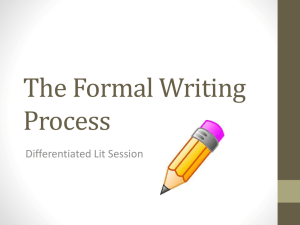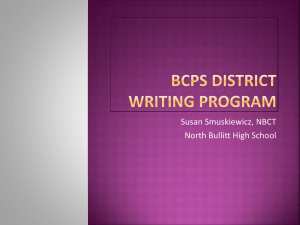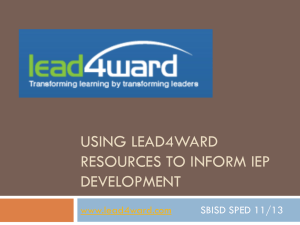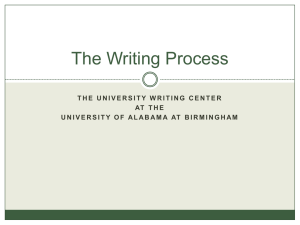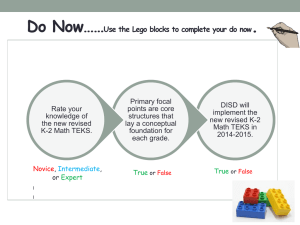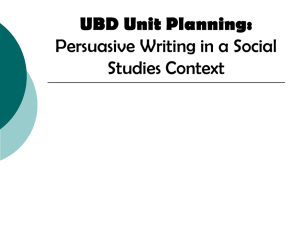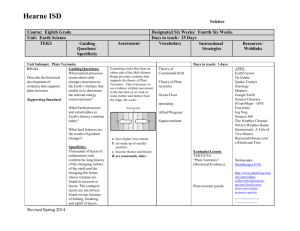CSCOPE Overview6thELAR4th nine weeks
advertisement
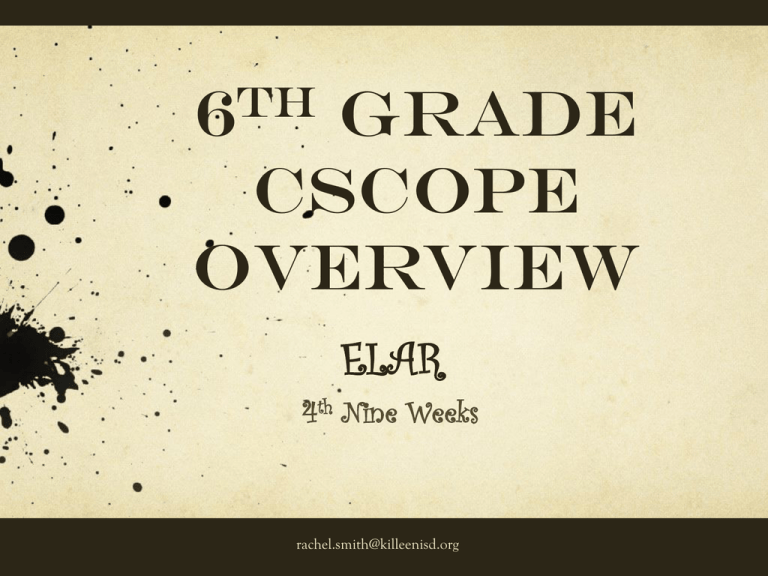
th 6 Grade CSCOPE Overview ELAR 4th Nine Weeks rachel.smith@killeenisd.org MISSION: Teach so that students learn to their maximum potential Vision: Through the implementation of a full, innovative, rigorous, comprehensive education program, KISD will provide superior learning opportunities so that upon graduation, students are prepared for success in the workforce and/or in higher education Community Commitments Understand that those who work, learn. Phrase questions and comments for the benefit of the group. Challenge ideas. Recognize that everyone has expertise. Look for solutions, not blame. UBD Understanding by Design 6.19(F) make connections (e.g., thematic links, author analysis) between and across multiple texts of various genres, and provide textual evidence. Vertical Alignment Study Grade Level and Content/Course__________________________ Strand:_______________________________________________ GRADE LEVEL TEKS BEFORE (5th) TEKS MY LANE GRADE LEVEL TEKS AFTER (7th) 6.19(F) COGNITIVE SPECIFICITY CONTENT TITLE Differences in Cognitive Specificity Differences in Content Specificity I – Introduced in my grade level T – Transformed in my grade level IFD Red-line TEKS with Specificity 6.19(F) make connections (e.g., thematic links, author analysis) between and across multiple texts of various genres, and provide textual evidence. Make CONNECTIONS BETWEEN AND ACROSS MULTIPLE TEXTS OF VARIOUS GENRES AND PROVIDE TEXTUAL EVIDENCE Including, but not limited to: Thematic links Author analysis Personal Connections World Connections Thematic links: a logical connection made between or among texts that share similar themes Author analysis: a process that connects the author's logical relationship to the text he/she wrote (e.g., perspective, purpose) Anchor Chart Content Objective Guiding Questions Key Academic Vocabulary Key Understandings Performance Indicators Compare and contrast the historical and cultural settings and theme of two literary works. In a small group, rewrite one of the scenes adapting the theme and setting into a different time period. Jigsaw the scenes among the groups and discuss how the scene was affected by the change. (6.FIG19F; 6.3A, 6.3C; 6.14A, 6.14B, 6.14C, 6.14D, 6.14E; 6.15Ai, 6.15Aii, 6.15Aiii; 6.19Ai, 6.19Aii, 6.19Aiii, 6.19iv, 6.19Av, 6.19Avi, 6.19vii, 6.19Aviii, 6.19B, 6.19C, 6.26A; 6.28A) Resources What activities/strategies meet the specificity of the TEKS? What activities/strategies will enable students to be successful on the performance indicator? What activities/strategies will enable students to be successful on multiple choice assessments? Modes of Writing Narration - telling a story Descriptive - painting a picture with words Persuasive - making an argument Expository – informing/ explaining Compare and Contrast How-To Cause/Effect Research - collecting information about something ACE Research ANSWER the question CITE evidence EXTEND and ELABORATE on how your evidence supports your answer. Imaginative - creating a new way of seeing things Stimulating Writing What am I writing about? TOPIC Why am I writing? PURPOSE • Entertain Inform Explain Persuade Reflect Who will read? AUDIENCE What is my main point? THESIS The Writing Process: Steps in Writing an Essay Pre-Writing Revising Final Copy/ Publish How can we help kids remember the writing process? Pigs Pre-writing Don’t Draft Really Revision Ever Editing Fly Final Copy/ Publish Pre-Writing Brainstorm or generate ideas for your topic. Choose a topic and organize ideas BEFORE actually starting to write. Use stimulus to generate ideas. Pre-Writing Stimulus Pictures, movies, an incident reported in the newspaper A story with a vivid theme Hexagonal Writing An essential question An event that “cries out” for a response A need to support or demonstrate learning A personal life experience Quick Write Art, object, or clip Pre-writing Activities Free Writing/Journaling Images or Illustration Graphic Organizers: Double Bubble, Flow Chart, Web Cluster Map, Classification Tree, Listing, Outline, T-Chart. Guided Practice –Cloze, Group Write Brainstorming – Individually or in Pairs Discussing Ideas -Peer, Partner, Teacher Note Taking – Cornell Notes, Outlining ACTIVITY: Create a Comparison Matrix Most Engaging Could Be Engaging Challenging Think through at least one “area” where you can create stimulus for good writing. Drafting Focus on Expanding on Ideas and Communicating a Message Talking to a neighbor, shoulder share, pair share, risk taking, available resources Consider expectations regarding pen or pencil, double spaced, singlesided, legibility, heading Move thoughts from the pre-writing (before writing) stage to where ideas and thoughts are put into complete sentences. The goal in writing a rough draft is to develop and support the ideas generated during pre-writing. Drafting Skip lines and only write on the front side of the paper, in order to have adequate room to revise and edit. Revision RATIOCINATION!! Ideas/Content, Word Choice, Organization, Sentence Fluency, Voice Keep, Delete, Substitute Focus on content- Look for ways to improve your paper Predict, Summarize, Clarify, Question Conferences – – – – Whole Class Roving One on One Peer Punctuation Indenting Paragraphs Spelling Grammar Final Copy/ Publishing Post on classroom wall, in library, in main office in newsletter etc. Share the Final Product or a Piece Writing Competitions Get Feedback Invite Discussion Celebrate Online Publishing Resources 6+1 Traits of Writing, Ruth Culham Four Square Writing Method, J. and E.J. Gould Creating Writers, Vicki Spandel Writing Essentials, Regie Routman

